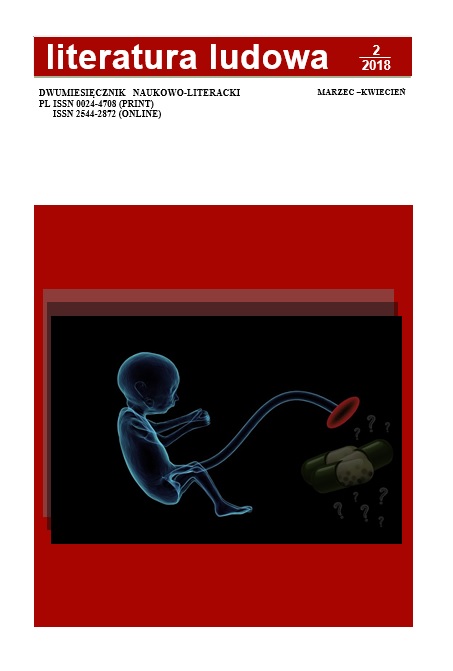Placentophagy: A Trend, a Myth or a Therapy?
DOI:
https://doi.org/10.12775/LL.2.2018.001Keywords
placenta, placentophagy, woman, pregnancy, birth, child, impurity, tabooAbstract
The article describes the increasingly popular phenomenon of placentophagy. It is becoming more and more common in the First World countries of the West, where a woman can take her placenta home after delivering a baby. It is forbidden under the Polish law. The first part of the text focuses on the origins of placentophagy, the reasons for its popularity and for showcasing motives for which people eat parts of their own bodies. The text explores opinions confirming the positive impact of placenta consumption and the medical evidence refuting the majority of these theses. The second part of the article is in turn focused on practices of treating placenta in traditional culture and the reasons for which placenta consumption was strictly forbidden in the past. Finally, it seeks to explain what has led to the dramatic changes in the perception of placentophagy.
References
BARTHES, R. (2008). Mitologie (przeł. A. Dziadek, wstęp A. Kłosiński). Warszawa: Aletheia.
BAUDRILLARD, J. (2006). Społeczeństwo konsumpcyjne. Jego mity i struktury (przeł. S. Królak). Warszawa: Sic!
BURSZTA, W. J. (1996) Czytanie kultury. Pięć szkiców, Łódź: Instytut Etnologii i Antropologii Kulturowej UAM w Poznaniu.
COYLE, C. W., Hulse, K. E., Wisner, K. L., Driscoll, K. E., Clark, C. T. (2015) Placentophagy: therapeutic miracle or myth? “Archives of Women’s Mental Health”, 18, 673-680. doi 10.1007/s00737-015-0538-8.
DOUGLAS, M. (2007). Czystość i zmaza (przeł. Marta Bucholc). Warszawa: PIW.
GERLICH, H. (1984). Narodziny, zaślubiny, śmierć. Zwyczaje i obrzędy w katowickich rodzinach górniczych. Katowice: Śląski Instytut Naukowy.
HAYES, E. H. (2015). Consumption of the Placenta in the Postpartum Period. “Journal of Obstetric, Gynecologic & Neonatal Nursing”, 45, 78-89. doi: 10.1016/j.jogn.2015.10.008
HOŁÓWKA, T. (1986), Myślenie potoczne. Heterogeniczność zdrowego rozsądku, przedmową opatrzył M. Czerwiński, Warszawa: PIW.
JOSEPH, R., Giovinazzo, M., Brown, M. (2016). A Literature Review on the Practice of Placentophagia. “Nursing for Women’s Health”, 20, 476-483. doi: 10.1016/j.nwh.2016.08.005
KOWALSKI, P. (2011). Ekskrementy i defekacja. Przerażenie, wstyd i instrukcja obsługi, „Znaczenia. Kultura – Komunikacja – Społeczeństwo”, 5.
KRISTAL, M. B., DiPirro, J. M. & Thompson, A. C. (2012). Placentophagia in Humans and Nonhuman Mammals: Causes and Consequences. “Ecology of Food and Nutrition”, no. 51(3), p. 177-197. doi: 10.1080/03670244.2012.661325.
KRISTEVA, J. (2007). Potęga obrzydzenia. Esej o wstręcie (przeł. M. Falski). Kraków: WUJ.
ŁEŃSKA-BĄK, K. (2018). Natchniony przez Boga skutecznie uleczy… Przypadek Jana Fabisiaka. W: M. Dąsal (red.), Medycyna a religia, Wrocław (w druku).
MARRACCINI, M. E., Gorman, K. S. (2015). Exploring Placentophagy in Humans: Problems and Recommendations. PubMed.gov. “Juornal of Midwifery & Women’s Health”, 60, 371-379. doi 10.1111/jmwh.12309.
PALUCH, A. (1995). Etnologiczny atlas ciała ludzkiego i chorób. Wrocław: Wydawnictwo Uniwersytetu Wrocławskiego.
POMIAN, K. (2006). Historia. Nauka wobec pamięci, Lublin: Wydawnictwo Uniwersytetu Marii Curie-Skłodowskiej.
ROBOTYCKI, Cz. (1998). Nie wszystko jest oczywiste. Kraków: WUJ.
ROUX, J.-P. (2013). Krew. Mity, symbole, rzeczywistość (przeł. M. Chrobak). Kraków: Znak.
SZTANDARA, M. (2002). „Dotknięcie” natury. „Literatura Ludowa”, 1, s. 21-32.
TRACZYK, Wł. (1989). Fizjologia człowieka w zarysie. Warszawa: Państwowy Zakład Wydawnictw Lekarskich.
TYLKOWA, D. (2000). Podhale. Tradycja we współczesnej kulturze wsi, Kraków 2000: Instytut Archeologii i Etnologii PAN.
WASILEWSKI, J. (2010). Tabu. Warszawa: Wydawnictwo Uniwersytetu Warszawskiego.
ZADROŻYŃSKA, A. (2002). Świętowanie polskie. Warszawa: Twój Styl.
ŁUCZAJ, Ł. (2015). Placentofagia. Ludzkie łożysko jako produkt kulinarny i leczniczy. Pozyskano z http://lukaszluczaj.pl/placentofagia-ludzkie-lozysko-jako-produkt-kulinarny-i-leczniczy/.
KELLER, Th. (2014). The Worst Things for Sale.
Pozyskano z http://theworstthingsforsale.com/2014/03/31/25-placenta-recipes/.
KARWATOWSKA, A. (2014). Z czym zjeść łożysko swojego dziecka. Pozyskano z
http://wyborcza.pl/TylkoZdrowie/1,137474,15998884,Z_czym_zjesc_lozysko_swojego_dziecka.html.
BURDA, K. (2015). Dlaczego niektóre kobiety po porodzie zjadają łożysko? Pozyskano z http://www.newsweek.pl/nauka/jedzenie-lozyska-po-porodzie-moda-ekoparentingu-czy-to-zdrowe-,artykuly,364698,1.html.
STĘPNIEWSKA, K. (2014). Zjadanie łożyska – moda celebry tek czy medycyna naturalna? Pozyskano z
REDD, N. (2012). I Regret Eating My Placenta. Pozyskano z https://parenting.blogs.nytimes.com/2012/03/25/i-regret-eating-my-placenta/?mcubz=0.
http://wiadomosci.gazeta.pl/wiadomosci/1,114881,4865094.html.
Downloads
Published
How to Cite
Issue
Section
License
1. The authors give the publisher (Polish Ethnological Society) non-exclusive license to use the work in the following fields:a) recording of a Work / subject of a related copyright;
b) reproduction (multiplication) Work / subject of a related copyright in print and digital technique (ebook, audiobook);
c) marketing of units of reproduced Work / subject of a related copyright;
d) introduction of Work / object of related copyright to computer memory;
e) dissemination of the work in an electronic version in the formula of open access under the Creative Commons license (CC BY - ND 3.0).
2. The authors give the publisher the license free of charge.
3. The use of the work by publisher in the above mentioned aspects is not limited in time, quantitatively nor territorially.
Stats
Number of views and downloads: 467
Number of citations: 0



